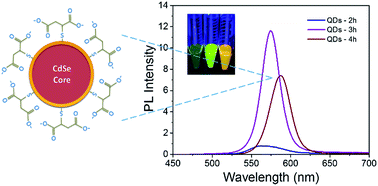Direct assembly of thioacid capped quantum dots in solid-state hybrid photovoltaics, effect of QDs size and thermal annealing†
Abstract
Deposition of colloidal quantum dot thin films to fabricate hybrid solar cells is strongly dependent on the nature of the quantum dot (QD) surface ligand. In order to reduce the fabrication cost and eliminate additional steps as the ligand-exchange, water soluble quantum dots (WSQDs) can be directly assembled in solid-state hybrid photovoltaics. In this paper we present the synthesis and characterization of solution processed quantum dot solar cells (QDSCs) with mercaptosuccinic acid (MSA) capped CdSe QDs as the active layer, rutile TiO2 nanorods (NRs) as the electron transport material (ETM) and Spiro-OMeTAD as the hole transport material (HTM). Narrow size distribution and surface coordination of the WSQDs were critical on the performance of the devices, with 3.5 nm CdSe QDs yielding the best power conversion efficiency (PCE). Annealing of the CdSe QD layer at 190 °C and room temperature infiltration of Spiro-OMeTAD into the active layer, simultaneously increased Voc, Jsc, and PCE. Proper annealing increases the QD size and removes linked water and excess ligands, contributing to QD packing and better electron-transport through the active layer. The improvement of Voc observed after further HTM infiltration, can be ascribed to the surface passivation of in-gap trap states and weak p-doping of QDs induced by 4-tert-butylpyridine, as evidenced by Kelvin probe measurements.



 Please wait while we load your content...
Please wait while we load your content...